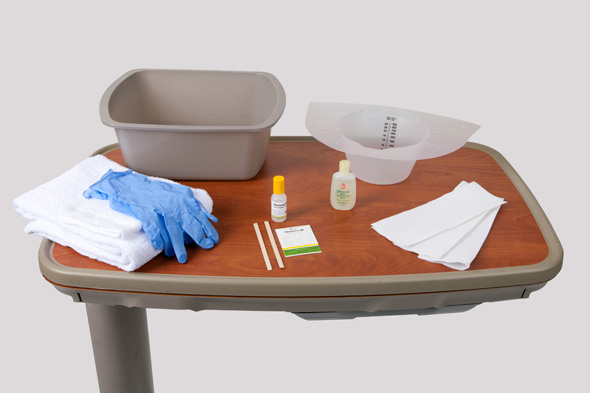Specimen Collection
Select a Skill:
- » Collecting a Midstream Urine Specimen
- » Performing Fecal Occult Blood Testing
- » Performing Gastric Occult Blood Testing
- » Collecting a Sputum Specimen
- » Collecting a Specimen for Wound Culture
- » Performing Blood Glucose Testing
- » Screening Urine for Chemical Properties
Take the Review Test:

Safety
- A false-negative result can occur if the patient is taking a vitamin C supplement.
- Specimens will be false positive if contaminated by menstrual blood, hemorrhoid blood, or povidone-iodine. Diets rich in meats, green leafy vegetables, poultry, and fish may produce false-positive results, as well as iron-containing medications or supplements.
- If the test for occult blood is positive:
- Continue to monitor the patient.
- Notify the health care provider.
Equipment
(Roll cursor over items to see labels)

Basin
Specimen hat
Soap
Washcloth and towel
Paper towels
Clean gloves
Wooden applicators
Hemoccult test - Cardboard Hemoccult slide
Hemoccult test - Hemoccult developing solution
Delegation
The skill of testing stool for occult blood can be delegated to nursing assistive personnel (NAP). Be sure to inform NAP of the following:
- The need to report to you immediately if blood is detected in the stool
- The importance of not discarding the stool from a positive test, so that the testing can be repeated if necessary
Preparation
- Assess the patient’s or family members’ understanding of the need for a stool test.
- Assess the patient’s ability to cooperate with the procedure and collect the specimen.
- Assess the patient’s medical history for gastrointestinal (GI) disorders such as a history of bleeding, colitis, or hemorrhoids.
- Review the patient’s medications for drugs that may contribute to GI bleeding.
- Refer to the health care provider’s orders for dietary modifications and medication or other restrictions before the test.
- Arrange for any such prescribed dietary or medication restrictions.
- Explain the procedure to the patient and/or family members. Discuss the reason for stool specimen collection and how the patient can assist. Explain that feces must be free of urine and toilet tissue.
Follow-up
- Note the color changes in the guaiac paper.
- A single positive test result does not confirm bleeding or indicate colorectal cancer. To confirm a positive test result, the test must be repeated while the patient is on a meat-free, high-residue diet and has more in-depth testing prior to a diagnosis.
- Note the character of the stool specimen.
- If the patient is collecting the stool sample at home, ask the patient to explain the procedure.
Documentation
- Record the results of the test and a description of the stool characteristics.
- Report positive test results to the health care provider.
Review Questions
1. What is the initial step in preparing a fecal occult blood test?
 Determine the patient’s ability to help obtain a sample.
Determine the patient’s ability to help obtain a sample.  Gather both a Hemoccult slide and developing solution.
Gather both a Hemoccult slide and developing solution. Remind the patient that we test one section of the bowel movement.
Remind the patient that we test one section of the bowel movement. Use Gastroccult developer with Hemoccult developer.
Use Gastroccult developer with Hemoccult developer.
2. The nurse has delegated to nursing assistive personnel (NAP) the task of performing fecal occult blood tests on the stool of a patient with a history of positive results. Which instruction is most relevant to performing this test in this particular patient?
 “Notify me only if the test is positive.”
“Notify me only if the test is positive.”  “Save the stool sample so that I can retest it if it is positive.”
“Save the stool sample so that I can retest it if it is positive.”  Remind the patient that we test one section of the bowel movement.
Remind the patient that we test one section of the bowel movement. Use Gastroccult developer with Hemoccult developer.
Use Gastroccult developer with Hemoccult developer.
3. Which instruction to nursing assistive personnel (NAP) is most relevant to the proper performance of a fecal occult blood test using a Hemoccult slide?
 “Be sure to wear sterile gloves.”
“Be sure to wear sterile gloves.”  “Reinforce with the patient the need to use the hat.”
“Reinforce with the patient the need to use the hat.”  “Is the patient capable of assisting with the collection?”
“Is the patient capable of assisting with the collection?”  “Remember to take samples from two different areas of the specimen.”
“Remember to take samples from two different areas of the specimen.”
4. Which statement indicates proper interpretation of the results of a positive fecal occult blood test?
 “If the sample turns blue, it is positive for bleeding.”
“If the sample turns blue, it is positive for bleeding.” “The sample turned blue after about 45 seconds.”
“The sample turned blue after about 45 seconds.” “The results were positive both times the sample was tested.”
“The results were positive both times the sample was tested.” “Because it was positive, the patient must be asked when he or she last ate red meat.”
“Because it was positive, the patient must be asked when he or she last ate red meat.”
5. Which of the following nursing actions addresses the risk for infection related to fecal occult blood testing?
 Maintaining aseptic technique while performing the test
Maintaining aseptic technique while performing the test  Performing the fecal occult blood testing in the patient’s bathroom
Performing the fecal occult blood testing in the patient’s bathroom  Wearing clean gloves while testing
Wearing clean gloves while testing  Assessing the patient’s ability to provide an uncontaminated fecal specimen
Assessing the patient’s ability to provide an uncontaminated fecal specimen
You have completed the Review Questions for this skill. To take the Review again select the Start Over button. To proceed to another skill select from the dropdown menu. Select the Home or Back button to proceed to the next section.

